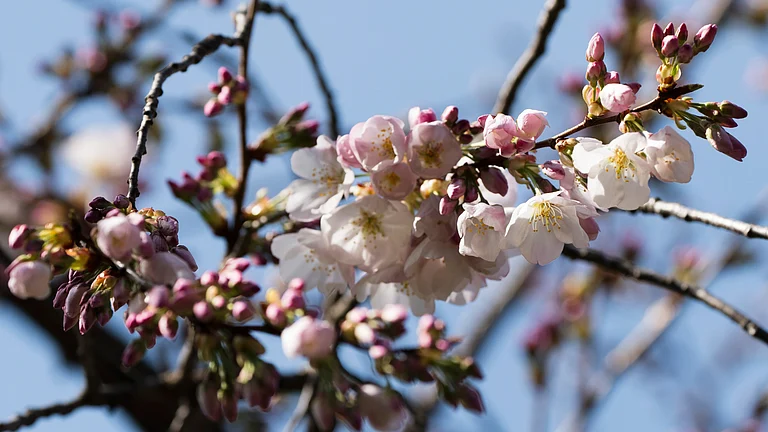Every spring, Washington D.C. undergoes a beautiful transformation. As the snow loosens its grip and temperatures rise, thousands of cherry trees lining the Tidal Basin emerge in a breathtaking display of delicate pink and white blossoms. This ephemeral spectacle, a fleeting reminder of snowfall amidst the burgeoning warmth, draws nearly a million visitors to the nation's capital for the awaited National Cherry Blossom Festival.
National Cherry Blossom Festival: Origin, History & Culture Of Washington DC
Washington’s most loved and awaited festival is just around the corner as the peak bloom has arrived early. Do you know the origin and history of this festival that arrives every spring?

The festival is a vibrant tapestry woven from cultural performances, historical commemorations, and, of course, the awe-inspiring floral display. With peak bloom expected between March 23 and 26, thanks to a recent trend of warmer winters, the festival offers a unique opportunity to witness the delicate beauty of these iconic trees.
A History Rooted in Friendship: The Gift of Cherry Blossoms
The story behind Washington D.C.'s cherry trees is as fascinating as the blossoms themselves. The original cherry trees, a gift from Japan in 1912, were championed by Eliza Scidmore, a remarkable woman whose name deserves wider recognition.
Scidmore, a travel writer and photographer, fell in love with the cherry blossoms during a trip to Japan in the late 19th century. Inspired, she set her sights on bringing this beauty to Washington D.C., a city then grappling with the aftermath of malaria and yellow fever outbreaks.
Undeterred by initial rejections, Scidmore found an ally in First Lady Helen Taft, who shared her appreciation for the elegance of the cherry trees. In 1912, thanks to their combined efforts, 1,000 cherry trees, a gift from the Mayor of Tokyo, arrived in Washington D.C.

Today, over 4,000 trees grace the Tidal Basin alone, with roughly 150 of the original Japanese specimens still thriving. The horticultural relationship between the two nations has been a two-way street, with Japanese gardeners even traveling to Washington in 1981 to obtain cuttings to replenish their own stock.
Eliza Scidmore witnessed the blossoming of her dream before her passing in 1928. While plaques commemorate the roles of Helen Taft and the Japanese ambassador's wife in planting the first tree, Scidmore's legacy remains largely unknown.
A Kaleidoscope of Events: From Parades to Performances
Beyond the visual feast of the blossoms themselves, the National Cherry Blossom Festival boasts a lively calendar of events. From colorful parades featuring marching bands and elaborate floats to captivating art exhibitions and a diverse range of cultural and sporting activities, there's something for everyone to enjoy. While most events are free and open to the public, some offer premium viewing experiences with reserved seating.
Music serves as a unifying thread throughout the festival. Renowned national and international artists take center stage, captivating audiences with their melodies. The festival literature promises "some 100 performances" this year, showcasing an exciting mix of dance styles including Japanese, Eastern European, Indian, and Flamenco. Acclaimed composer Kaoru Watanabe is also slated to enthrall audiences with his innovative fusion of Japanese culture and diverse musical influences.
A highlight for many is the annual National Cherry Blossom Festival Parade. This year, the parade is scheduled to be held on April 13, 2024. This extravagant display of floats, marching bands, and cultural performances winds its way through the heart of Washington D.C., drawing massive crowds and offering a vibrant glimpse into American pageantry.

A Celebration of Culture and Goodwill
The National Cherry Blossom Festival is more than just a celebration of springtime beauty. It fosters international goodwill, particularly between the United States and Japan. Young people passionate about Japanese culture are chosen as festival ambassadors, fostering connections across the Pacific.
The festival also serves a charitable purpose, raising funds for various causes. Scholarships are awarded to deserving high school students, while sports clubs in underprivileged areas receive financial support.
Beyond the official events, the festival fosters a spirit of community and cultural exchange. Restaurants offer special menus featuring Japanese cuisine, while shops stock their shelves with cherry blossom-themed merchandise. Visitors from all over the world converge on Washington D.C., creating a vibrant atmosphere that celebrates the beauty of spring and the enduring friendship between two nations.
- Previous Story
 US Elections 2024: Tim Walz, JD Vance To Go Head-To-Head In VP Debate | Key Issues To Watch Out For
US Elections 2024: Tim Walz, JD Vance To Go Head-To-Head In VP Debate | Key Issues To Watch Out For - Next Story




























